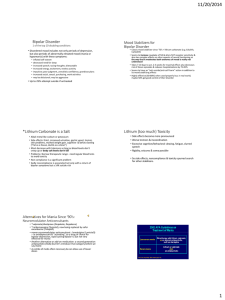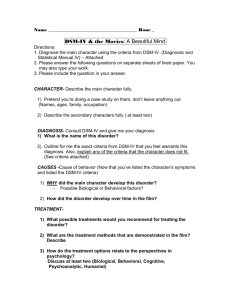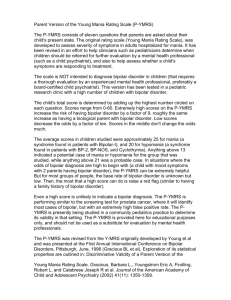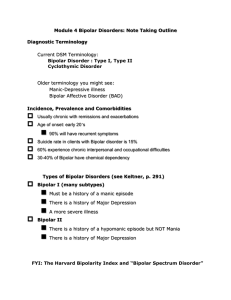The Development of New Diagnostic Criteria Sets for Pediatric
advertisement
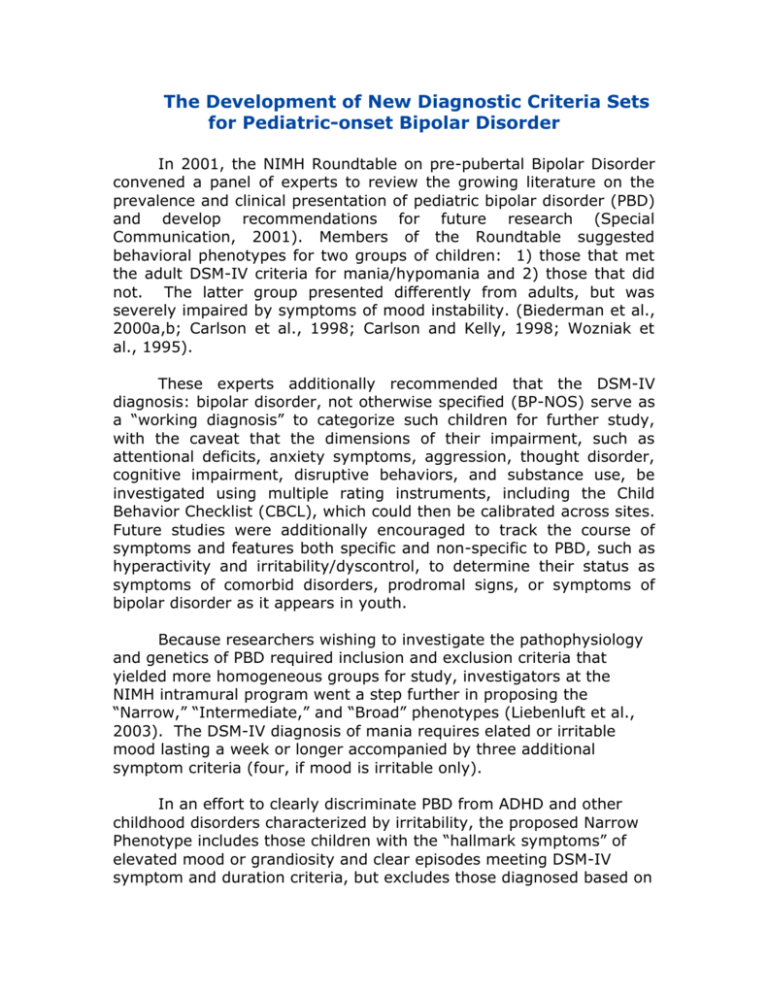
The Development of New Diagnostic Criteria Sets for Pediatric-onset Bipolar Disorder In 2001, the NIMH Roundtable on pre-pubertal Bipolar Disorder convened a panel of experts to review the growing literature on the prevalence and clinical presentation of pediatric bipolar disorder (PBD) and develop recommendations for future research (Special Communication, 2001). Members of the Roundtable suggested behavioral phenotypes for two groups of children: 1) those that met the adult DSM-IV criteria for mania/hypomania and 2) those that did not. The latter group presented differently from adults, but was severely impaired by symptoms of mood instability. (Biederman et al., 2000a,b; Carlson et al., 1998; Carlson and Kelly, 1998; Wozniak et al., 1995). These experts additionally recommended that the DSM-IV diagnosis: bipolar disorder, not otherwise specified (BP-NOS) serve as a “working diagnosis” to categorize such children for further study, with the caveat that the dimensions of their impairment, such as attentional deficits, anxiety symptoms, aggression, thought disorder, cognitive impairment, disruptive behaviors, and substance use, be investigated using multiple rating instruments, including the Child Behavior Checklist (CBCL), which could then be calibrated across sites. Future studies were additionally encouraged to track the course of symptoms and features both specific and non-specific to PBD, such as hyperactivity and irritability/dyscontrol, to determine their status as symptoms of comorbid disorders, prodromal signs, or symptoms of bipolar disorder as it appears in youth. Because researchers wishing to investigate the pathophysiology and genetics of PBD required inclusion and exclusion criteria that yielded more homogeneous groups for study, investigators at the NIMH intramural program went a step further in proposing the “Narrow,” “Intermediate,” and “Broad” phenotypes (Liebenluft et al., 2003). The DSM-IV diagnosis of mania requires elated or irritable mood lasting a week or longer accompanied by three additional symptom criteria (four, if mood is irritable only). In an effort to clearly discriminate PBD from ADHD and other childhood disorders characterized by irritability, the proposed Narrow Phenotype includes those children with the “hallmark symptoms” of elevated mood or grandiosity and clear episodes meeting DSM-IV symptom and duration criteria, but excludes those diagnosed based on irritable mood alone. The Intermediate Phenotype includes those with episodes of shorter duration and those with “irritable (hypo)mania.” The Broad Phenotype includes children who have explosive rages, aggression, hyperarousal (hyperactivity, distractibility) and chronic mood disturbance but meet neither DSM-IV symptom nor duration criteria, and excludes those who have discrete episodes and elated mood or grandiosity. The NIMH panel recommended that future studies use DSM-IV diagnoses as “descriptive data” and substitute the proposed phenotype definitions as inclusion/exclusion criteria (Liebenluft et al, 2003). The “Core” phenotype as defined in the Research Diagnostic Criteria places the DSM-IV manic or mixed episode in a broader framework of specific functional impairments directly related to the regulation of affect, drive, attention, arousal, and circadian rhythm, linked to defined neurobehavioral systems, and reflecting a neurobiological model informed by recent research. (Kalin & Shelton, 2000; Dolan 2002; LeDoux, 2000; Drevets, 1998; Blumberg et al. 2002; Papolos & Papolos, 2000; Xu et al., 2004). REFERENCES Biederman, J., Faraone, S.V., Wozniak, J., Monuteaux, M.C. (2000a). Parsing the association between bipolar, conduct, and substance use disorders: a familial risk analysis. Biol Psychiatry, 48(11):1037-44. Biederman, J., Mick, E., Faraone, S.V., Spencer, T., Wilens, T.E., & Wozniak, J. (2000b). Pediatric mania: a developmental subtype of bipolar disorder? Biol Psychiatry, 48(6):458-66. Blumberg HP, Charney DS, Krystal JH (2002). Frontotemporal neural systems in bipolar disorder. Semin Clin Neuropsychiatry, 7(4):243-54. Carlson, G.A. (1998). Mania and ADHD: comorbidity or confusion. J Affect Disord, 51(2):177-87. Carlson GA, Kelly KL. (1998). Manic symptoms in psychiatrically hospitalized children – what do they mean? J Affect Disord, 51: 123-135. Dolan, RJ. (2002). Emotion, cognition, and behavior. Science, 298:1191-1194. Drevets, WC. (1998). Functional neuroimaging studies of depression: the anatomy of melancholia. Annu Rev Med, 49: 341-361. Kalin, NH and Shelton, SE. (2000). The regulation of defensive behaviors in rhesus monkeys; implications for understanding anxiety disorders. In Anxiety, Depression and Emotion. Vol. 1. R. Davidson, Ed 50-68 Oxford University Press, N.Y. LeDoux, JE. (2000). Emotion circuits in the brain. Annu Rev Neuroscie, 23: 155-184. Leibenluft E, Charney DS, Towbin KE, Bhangoo RK, Pine DS. (2003) Defining clinical phenotypes of juvenile mania. Am J Psychiatry, 160(3):430-437. Papolos, D.F. and Papolos, J.D. (2002). The Bipolar Child: The Definitive and Reassuring Guide to One of Childhood's Most Misunderstood Disorders. 2nd Edition, Broadway Books, N.Y., New York. Wozniak J, Biederman J, Kiely K, Ablon JS, Faraone SV, Mundy E, Mennin D. (1995). Mania-like symptoms suggestive of childhood-onset bipolar disorder in clinically referred children. J Am Acad Child Adolesc Psychiatry, 34(7):867-76. Xu, Y-L, Reinscheid RK, Huitron-Resendiz S, Clark SD, Wang Z, Lin SH, Brucher FA, Zeng J, Ly NK, Henriksen, SJ, de Lecea L, Civelli O. (2004). Neuropeptide S: a neuropeptide promoting arousal and anxiolytic-like effects. Neuron. 43(4). 487-97.
